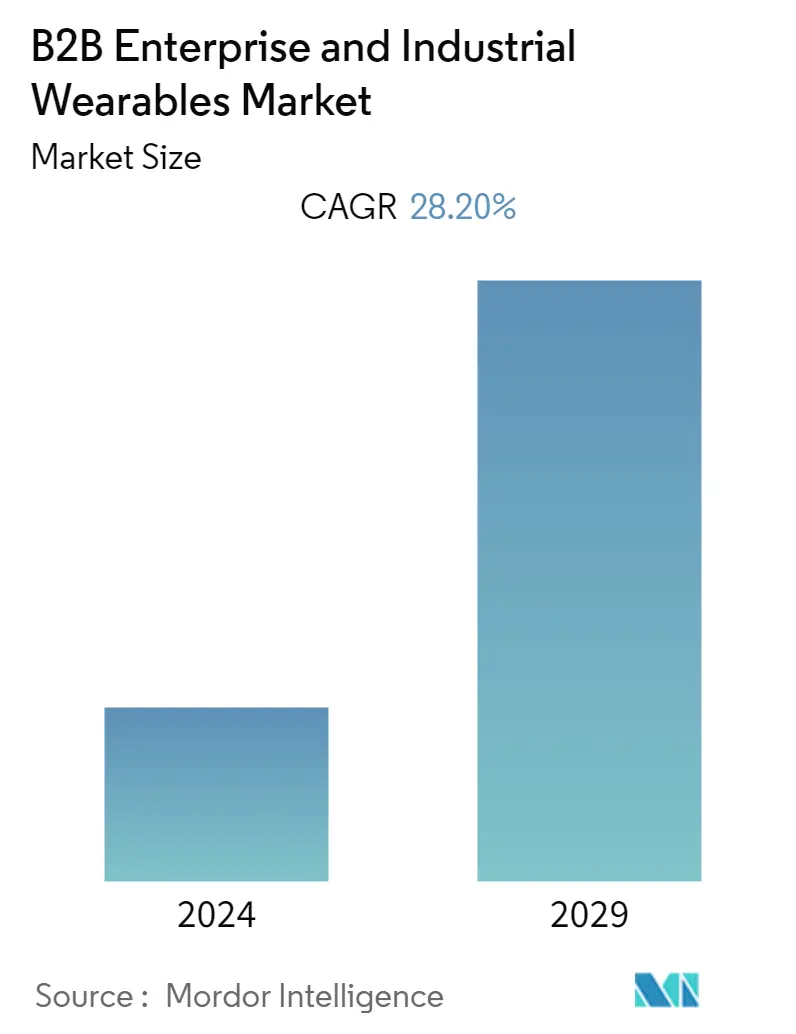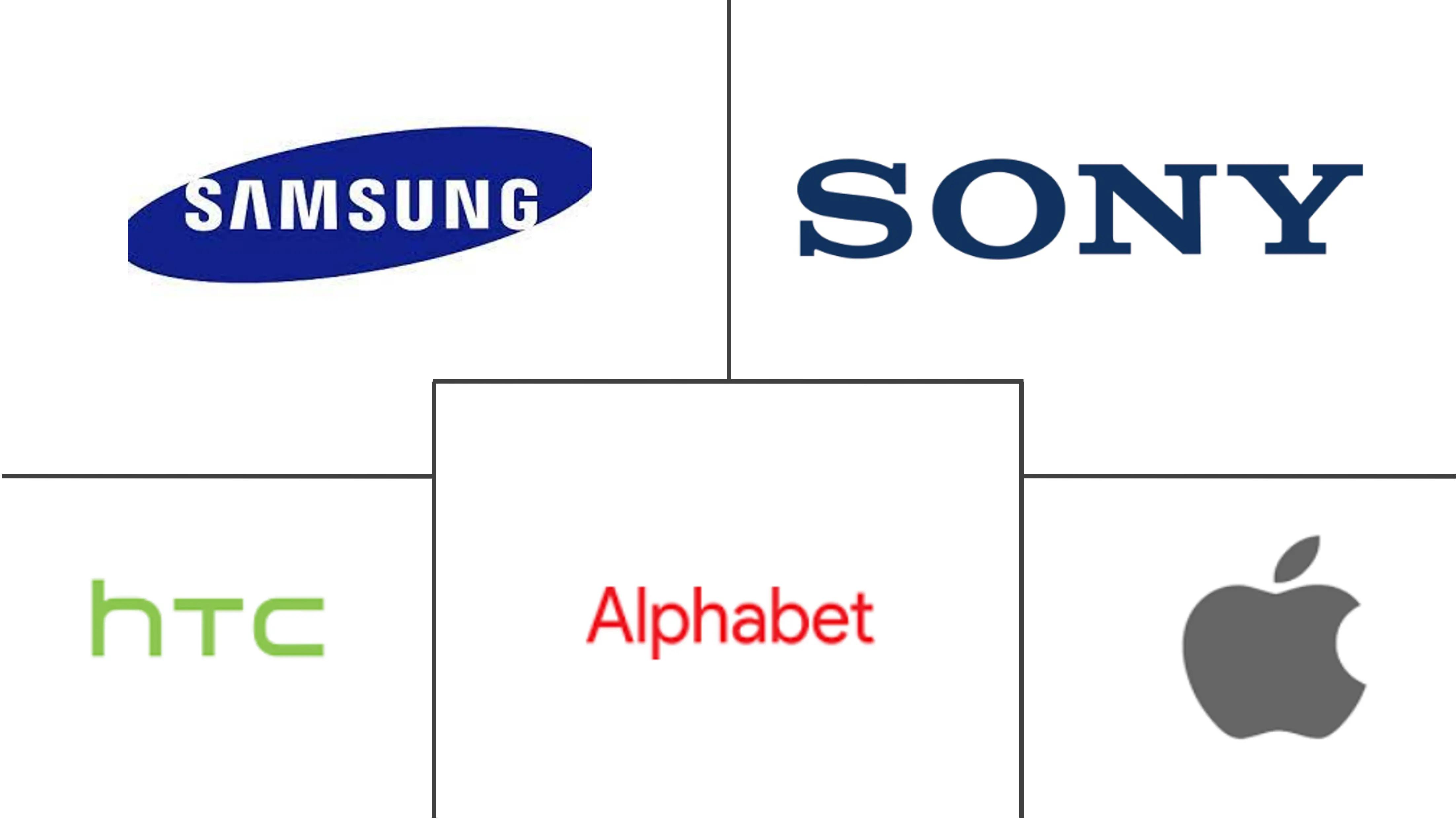Market Size of B2B Enterprise & Industrial Wearables Industry

| Study Period | 2019 - 2029 |
| Base Year For Estimation | 2023 |
| CAGR | 28.20 % |
| Fastest Growing Market | Asia Pacific |
| Largest Market | North America |
| Market Concentration | High |
Major Players
*Disclaimer: Major Players sorted in no particular order |
B2B Enterprise & Industrial Wearables Market Analysis
The B2B Enterprise & Industrial Wearables Market is expected to witness a CAGR of 28.2% over the forecast period. B2B enterprise and industrial wearables devices are valuable tools for improving workplace productivity, safety, and quality in manufacturing, logistics, healthcare, and lifestyle. These devices are advanced electronic components that collect data, monitor behaviors, and provide personalized experiences based on user's needs and preferences.
- The wearables market in an enterprise setup is in its infancy, with a significant share of the applications designated to enhancing customer experience. Wearables are extensively used to access customer data in real-time, view business analytics, and produce immersive customer experiences, factory operations, and training.
- Global enterprise IT organizations have now recognized the benefits of wearables, thereby developing and providing businesses with a way to automate the deployment of modern applications at scale, which drives the demand for enterprise adoption with the growing mobile app ecosystem. Mobile apps can build loyal customer bases, provide insightful customer data, and more. Businesses should understand how these apps can enhance CX, especially if they maintain close contact with customers or business partners.
- The demand for smart factory setups aids the growth of the wearables market. Governments worldwide are becoming aware of the significant potential of innovative manufacturing technologies. Therefore, they support and fund R&D for technologies such as IIoT and expect to become potential adopters of the technology and private firms. They financially support new IoT projects and implementations to build and run smart factory setups.
- Technical obstacles such as longer operating times, which are currently constrained by battery life and the limitations of other power sources, the balance between faster data transmission (for real-time operations) and low power consumption, weight reduction, and biocompatibility are expected to hinder the growth of B2B wearables. Data privacy concerns may slow the adoption of wearables in the B2B setup, where sensitive data is circulated through a network of wearables.
- The COVID-19 pandemic highly impacted the wearables market. The global prices of consumer electronics witnessed a rise initially owing to the partial clampdown on manufacturing facilities; critical components such as NFC chips and RFID tags faced a slowdown in their supply chain. However, the market was positively impacted post-pandemic, accelerating the rise of the digital economy, particularly wearable devices such as smartwatches.
B2B Enterprise & Industrial Wearables Industry Segmentation
Wearable technology consists of devices that use wearable sensors to track data about self-monitoring, personal responsibility, and creating awareness about the operating surroundings of an employee. Industrial wearable devices are designed to improve workplace productivity, safety, and efficiency in sectors like manufacturing, logistics, and mining. These devices collect data in real time, track activities, provide alerts, and provide customized experiences depending on the needs of the users and organizational objectives. They are designed for specific situations or industry verticals against consumer wearables, which are often general in function.
The B2B Enterprise and industrial Wearables Market is Segmented by Device Type (HMDs, Wrist Wears, Enterprise Smart Glass, Wearable Cameras, and Other Device Types), End-user Industry (IT and Telecom, Healthcare, Retail, Insurance, Manufacturing, Other End-user Industries), and Geography (North America, Europe, Asia-Pacific, and the Rest of the World). The market sizes and forecasts are provided in terms of value (USD) for all the above segments.
| By Device Type | |
| HMDs | |
| Wrist Wears (Smart Watch and Fitness Bands) | |
| Enterprise Smart Glass | |
| Smart Clothing and Body Sensors | |
| Wearable Cameras | |
| Other Device Types |
| By End-user Industry | |
| IT and Telecom | |
| Healthcare | |
| Retail | |
| Insurance | |
| Manufacturing | |
| Other End-user Industries |
| By Geography | |
| North America | |
| Europe | |
| Asia-Pacific | |
| Rest of the World |
B2B Enterprise & Industrial Wearables Market Size Summary
The B2B Enterprise & Industrial Wearables Market is poised for significant growth, driven by the increasing adoption of advanced wearable technologies across various sectors such as manufacturing, logistics, healthcare, and lifestyle. These devices, which include smart glasses and augmented reality tools, are designed to enhance workplace productivity, safety, and quality by collecting data, monitoring behaviors, and providing personalized experiences. The market is still in its early stages, with a substantial focus on improving customer experiences and streamlining business operations through real-time data access and immersive training solutions. The rise of smart factory setups and government support for innovative manufacturing technologies further bolster the market's expansion, despite challenges like technical limitations and data privacy concerns.
North America is expected to dominate the market due to its high adoption rate of wearable technologies, robust internet penetration, and significant government investment in research and development. The presence of major market players in the region, coupled with continuous innovation and integration of technologies like NFC for payment functionalities, enhances the appeal of wearable devices. The market's consolidation, with a few key players leading, is anticipated to evolve as technology becomes more accessible and its applications broaden in labor-intensive sectors. The future of the market looks promising, with ongoing developments in smart manufacturing and military applications, indicating a growing demand for wearable devices in various high-tech environments.
B2B Enterprise & Industrial Wearables Market Size - Table of Contents
-
1. MARKET DYNAMICS
-
1.1 Market Overview
-
1.2 Market Drivers
-
1.2.1 Growing App Ecosystem Will Fuel Enterprise Adoption
-
1.2.2 Demand for Smart Factory Setups are Expected to Aid Growth of Wearables
-
-
1.3 Market Restraints
-
1.3.1 Lack of Business Applications is a Primary Challenge in Deploying Wearables
-
1.3.2 Perennial Concerns about Data Security and Existing Tech Integration Issues
-
-
1.4 Industry Attractiveness - Porter's Five Forces Analysis
-
1.4.1 Threat of New Entrants
-
1.4.2 Bargaining Power of Buyers/Consumers
-
1.4.3 Bargaining Power of Suppliers
-
1.4.4 Threat of Substitute Products
-
1.4.5 Intensity of Competitive Rivalry
-
-
1.5 Industry Value Chain Analysis
-
1.6 Impact of COVID-19 on the Market
-
-
2. MARKET SEGMENTATION
-
2.1 By Device Type
-
2.1.1 HMDs
-
2.1.2 Wrist Wears (Smart Watch and Fitness Bands)
-
2.1.3 Enterprise Smart Glass
-
2.1.4 Smart Clothing and Body Sensors
-
2.1.5 Wearable Cameras
-
2.1.6 Other Device Types
-
-
2.2 By End-user Industry
-
2.2.1 IT and Telecom
-
2.2.2 Healthcare
-
2.2.3 Retail
-
2.2.4 Insurance
-
2.2.5 Manufacturing
-
2.2.6 Other End-user Industries
-
-
2.3 By Geography
-
2.3.1 North America
-
2.3.2 Europe
-
2.3.3 Asia-Pacific
-
2.3.4 Rest of the World
-
-
B2B Enterprise & Industrial Wearables Market Size FAQs
What is the current B2B Enterprise & Industrial Wearables Market size?
The B2B Enterprise & Industrial Wearables Market is projected to register a CAGR of 28.20% during the forecast period (2024-2029)
Who are the key players in B2B Enterprise & Industrial Wearables Market?
Alphabet Inc., Samsung Electronics Co. Ltd., Sony Corporation, HTC Corporation and Apple Inc are the major companies operating in the B2B Enterprise & Industrial Wearables Market.

